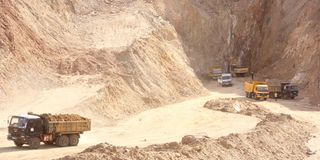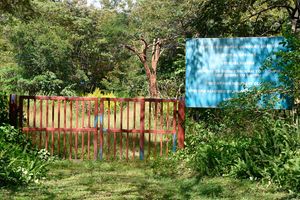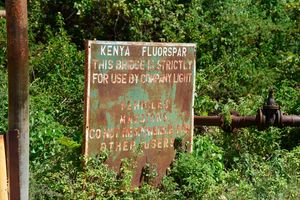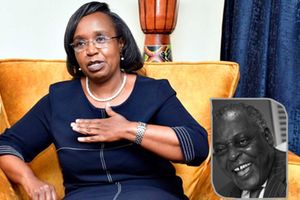
Fluorspar mining section at Kenya Fluorspar Company Limited, in Elgeyo-Marakwet County on February 23, 2016.
The anticipated mining of fluorspar in Elgeyo Marakwet County will take longer than had been expected despite the government signing an agreement last year with a United Kingdom-based company to pump Sh4.8 billion into the revival of Kenya Fluorspar Company.
The planned revival of the company has been hit by logistical and organisational challenges, a year after the Ministry of Mining, Blue Economy and Maritime Affairs handed over the tendering process to a consortium led by M/S Soy Fluorspar Ltd in joint venture with M/S Fujax Ltd and M/S Fujax East Africa Ltd.
Kerio Valley residents had hoped that the signing of the agreement early last year would jump-start the operations of the company.
Under the deal, the government was to retain a 15 percent stake in the company.
The delayed restoration of the firm that formed the socio-economic livelihood of Kerio Valley residents has triggered anxiety among the local leadership and residents, who have petitioned the government to intervene.
“We fail to understand why the recovery of the company that offered employment to over 3,000 people and indirectly supported 10,000 others has not kicked off almost a year after the government signed the deal,” said Keiyo South MP Gideon Kimaiyo. The mining firm is located in his constituency.
At its peak, the company exported over 106,000 tonnes of fluorspar before it scaled down its operations in 2014 and ultimately halted operations in 2016 due to dwindling international market prices for the minerals.
It had assets worth over Sh5 billion and employed over 3,000 people formally and informally contributing to the growth and development of the economy of the semi-arid Kerio Valley region.
The company paid an average of Sh20 million monthly for electricity, contributing a huge share of revenue to the government.
“It is our appeal that the government moves with speed and resolve the underlying factors that have delayed the planned revival of the firm,” the lawmaker appealed to President William Ruto when the Head of State attended a church service in the area at the weekend.
Then Cabinet Secretary for Mining and Blue Economy Salim Mvurya, Soy Fujax UK Director Hendrick Ryst, and the firm’s boss for East Africa John Masada signed the agreement in February last year, ending the long wait for the revival of the fluorspar firm.
The consortium was expected to begin work immediately, but a year down the line minimal activities have taken place at the site.
It has emerged that the company is still finalising documentation, including approvals from the National Environment Management Authority (Nema), fixing of machines, and refurbishing the factory and houses.
The compensation of more than 500 families displaced from their ancestral land to allow for mining activities remains a thorny issue despite a pledge by the government to address the issue alongside the revival of the firm.
The families are demanding Sh3 million per acre for what they claim is 921 acres of the mining field.
Members of the Kimwarer Sugutek (Fluorspar) community, who were displaced from the 9,070 acres of ancestral land, have been holding a series of Environmental Impact Assessment meetings with teams from the national and county on how to resolve the long-standing compensation dispute.
“The community members are upbeat that they will receive their dues alongside revival plans of the firm to empower them to engage in other meaningful economic activities,” said Micah Kigen, who has been instrumental in the compensation and company revival efforts.
The exit of the Kerio Valley-based mining company leaves South Africa and Morocco as the remaining African countries in the world market.
South Africa produces 300,000 tonnes annually, Morocco produces 100,000 tonnes and Kenya produces an average of 120,000 tonnes but the depressed market has impacted negatively the once lucrative mineral sector.
China produces 60 percent and Mexico 20 percent of fluorspar in the world but the entry of other producers complicated the market situation resulting in the closure of mining firms, including the Kenya Fluorspar and others in Bulgaria.
Some of the markets that were affected by the closure of the company include Muskut, Kimwarer, Turesia, Kabokbok, Kowochii, and several trading centres in the entire Soy division.
“Only three out of 13 shops survived when the company suspended its operations in 2009/2010 but the current move has dealt a major blow to us,” said Leah Jepkurui, a hotelier at Kimwarer Market.
The Kerio Valley belt is attracting massive attention after the striking of oil in Turkana County and the impending mining of other minerals in the basin.
Apart from the black gold in Kodekode in Nakukulas, Turkana East, fluorspar, limestone, gold, marble, gypsum, kasline, talc and diatomite are among the minerals that have attracted explorers to the region.
Geotechnical investigations by the Kerio Valley Development Authority (KVDA) have established deposits of talc at Sook village in West Pokot County and diatomite at Bartabwa in Baringo County within the Kerio Valley basin, making it a centre of attraction for the impending riches.
The riches of Kerio Valley are boosted by the availability of marble at Koitilial village in Marakwet and gypsum in Turkana County.
The geothermal potential in Lake Baringo and solar power in Lake Turkana offer the Kerio Valley basin the potential to emerge as an economic giant in line with Vision 2030.









